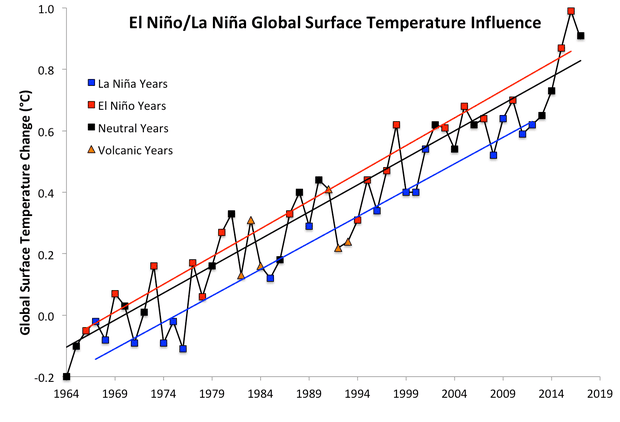
2017 was the second-hottest year on record according to Nasa data, and was the hottest year without the short-term warming influence of an El Niño event:
In fact, 2017 was the hottest year without an El Niño by a wide margin – a whopping 0.17°C hotter than 2014, which previously held that record. Remarkably, 2017 was also hotter than 2015, which at the time was by far the hottest year on record thanks in part to a strong El Niño event that year.
For comparison, the neutral El Niño conditions and the level of solar activity in 1972 were quite similar to those in 2017. 45 years later, the latter was 0.9°C hotter than the former. For each type of year – La Niña, El Niño, and neutral – the global surface warming trend between 1964 and 2017 is 0.17–0.18°C per decade, which is consistent with climate model predictions.

1964–2017 global surface temperature data from Nasa, divided into El Niño (red), La Niña (blue), and neutral (black) years, with linear trends added. Illustration: Dana Nuccitelli
I’ve been writing for the Guardian for almost 5 years now, and every year I’ve had to write a similar headline or two:
Those early years were the height of the denier frenzy about the mythical global warming ‘hiatus.’ At the time, John Abraham and I frequently wrote pieces pointing out that while various factors were temporarily dampening global surface warming, the oceans (which absorb over 90% of the excess heat from the increased greenhouse effect) continued warming rapidly.
It was only a matter of time until short-term effects stopped holding back the rise of Earth’s surface temperatures. That’s now happened, and as a result we’re seeing unleashed global warming causing record temperatures year after year. In fact, in February 2014 I wrote about a study that predicted this would happen:
the [ocean] heat uptake is by no means permanent: when the trade wind strength returns to normal - as it inevitably will - our research suggests heat will quickly accumulate in the atmosphere. So global temperatures look set to rise rapidly out of the hiatus, returning to the levels projected within as little as a decade.
Temperatures have in fact risen so quickly, it appears to have taken just a few years for that prediction to come true and for the denier focus on the short-term surface warming slowdown to look quite foolish.
Speaking of climate denial, on the 362nd day of the hottest year on record without an El Niño, the US president tweeted this:
Posted by dana1981 on Tuesday, 2 January, 2018
 |
The Skeptical Science website by Skeptical Science is licensed under a Creative Commons Attribution 3.0 Unported License. |